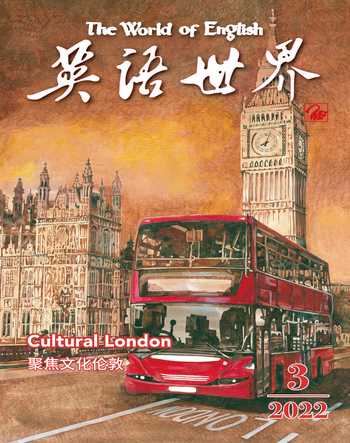The River Thames泰晤士河
M. F. 曼斯菲尔德 宁一中
【導读】泰晤士河发源于英格兰西南部的科茨沃尔德山,全长346公里,横贯英国首都伦敦,在伦敦下游注入北海。泰晤士河尽管不如长江之滚滚滔滔,但它哺育了英国的灿烂文化,是英国人的母亲河。河的两岸有许多著名建筑,如宏伟的威斯敏斯特大教堂、标志着英国黑暗时期的伦敦塔、可以升降的塔桥等。伊顿、牛津等文化场所亦闻名于世。英国历代文人都有对它的礼赞。本篇译自《狄更斯笔下的伦敦》(Dickens London)之“泰晤士河”(The River Thames),有删节。
Ever present in the minds and hearts of the true Londoner is the “majestic Thames;” though, in truth, while it is a noble stream, it is not so all-powerful and mighty a river as romance would have us believe.
From its source, down through the Shires, past Oxford, Berks, and Bucks, and finally between Middlesex, Surrey, and Essex, it ambles slowly but with dignity. From Oxford to Henley and Cookham, it is at its best and most charming stage. Passing Maidenhead, Windsor, Stains, Richmond, Twickenham, and Hammersmith, and reaching Putney Bridge, it comes into London proper, after having journeyed on its gladsome way through green fields and sylvan banks for a matter of some hundred and thirty miles.
Poets have sung its praises, and painters extolled its charms. To cite Richmond1 alone, as a locality, is to call up memories of Sir Joshua Reynolds2, Walpole3, Pope4, Thomson5, and many others whose names are known and famed of letters and art.
If swans are characteristic of the upper reaches, the waterman or the bargeman, assuredly, is of the lower. With the advent of the railway, —which came into general use and effective development during Dickens day, —it was popularly supposed that the traffic of the “silent highway”6 would be immeasurably curtailed.
Coming to London proper, from “Westminster” to the “Tower,” there is practically an inexhaustible store of reminiscence to be called upon, if one would seek to enumerate or picture the sights, scenes, and localities immortalized by even the authors contemporary with Dickens.
In Dickens time, that glorious thoroughfare, known of all present-day visitors to London, the Victoria Embankment7, was in a way non-existent. In the forties there was some agitation for a new thoroughfare leading between the western and the eastern cities.
The Thames in London proper was, in 1850, crossed by but six bridges. Blackfriars Railway Bridge, Charing Cross Railway Bridge, and the Tower Bridge did not come into the ensemble till later, though the two former were built during Dickens lifetime.
Westminster Bridge, from whence the Embankment starts, was the second erected across the Thames. It appears that attempts were made to obtain another bridge over the Thames besides that known as “London Bridge,” in the several reigns of Elizabeth, James I., Charles I. and II., and George I.; but it was not until the year 1736 that Parliament authorized the building of a second bridge, namely, that at Westminster. Prior to this date, the only communication between Lambeth and Westminster was by ferry-boat.
On the 1st of May, 1845, Hungerford Suspension Bridge was opened to the public without ceremony, but with much interest and curiosity, for between noon and midnight 36,254 persons passed over it. Hungerford was at that time the great focus of the Thames Steam Navigation, the embarkation and landing exceeding two millions per annum. The bridge was the work of Sir I. K. Brunel, and was a fine specimen of engineering skill. It was built without any scaffolding, with only a few ropes, and without any impediment to the navigation of the river. The entire cost of the bridge was ?110,000, raised by a public company.
“Billingsgate” was one of the earliest water-gates of London, the first on the site having been built in the year 400 B. C., and named after Belin, King of the Britons. The present “Billingsgate Market” is a structure completed in 1870.
Below the metropolis of docks and moorings the river widens to meet the sea, so that any journey of observation must perforce be made upon its bosom rather than as a ramble along its banks.
Opposite Gravesend, from where Dickens first set sail for America, is Tilbury Fort, a reminder of the glories of Englands arms in the days of Elizabeth. It may be said to be the real outpost of London. Here passing from the “Lower Hope” into “Sea Reach,” we fairly enter upon the estuary of the Thames. Here the river has rapidly expanded into an arm of the sea, having widened from two hundred and ninety yards at London Bridge to perhaps four and a half miles at the “London Stone” by Yantlet Creek, where the jurisdiction of the Corporation of London ends.
To the north the Essex shore trends rapidly away toward Yarmouth; to the south straight to the eastern end of the English Channel, past the historic Medway, with Gads Hill Place and Higham.
Beyond is Strood, Rochester, Chatham, Maidstone, Canterbury, and Broadstairs, and with the latter place one takes leave, as it were, of England, Dickens, and his personal and literary associations therewith.
縈绕在真正的伦敦人脑海里、心坎上的,莫过于那条“威严的泰晤士河”了。实际上,说它是一条高贵的溪流倒也没错,说它像传奇故事里让我们相信的那样波澜壮阔,则满不是那么回事。
泰晤士河由源头顺诸郡而下,流经牛津、伯克和白金汉,最后穿过米德尔赛克斯、萨里和埃塞克斯,一路悠然而威严地流淌。从牛津到亨利镇和库克汉姆这一段是最壮观、最美丽的。经梅登黑德、温莎、斯特恩斯、里士满、特维克纳姆和汉默史密斯到普特尼桥,就到了伦敦市区。一路流来,长约130英里,两岸绿满田畴,树木森森,令人心旷神怡。
诗人们写诗歌颂它,画家们以画笔赞颂它的妩媚。只说里士满这个地方,就唤起人们对乔舒亚·雷诺兹、沃尔波尔、蒲柏、汤姆森等诸多因文学艺术而名传遐迩的大家们的记忆。
假若上游的特色是天鹅的话,那么下游的特色定然就是船工和驳船船员了。自从有了铁路(狄更斯的时代,铁路已广泛使用、有效开发),人们就普遍认为“安静公路”上的交通运输会大大减少。
来到伦敦市区,如果有人要历数或描绘因狄更斯那一辈的作家而变得不朽的地方或景观,从威斯敏斯特大教堂到伦敦塔,几乎有说不尽道不完的记忆。
在狄更斯那時候,维多利亚堤岸这条如今来伦敦的游客都知道的通衢大道从某种程度上说还不存在。19世纪40年代有人提议要修一条贯通伦敦西城和东城的新大道。
1850年,伦敦市区的泰晤士河河段上只有6座桥。黑衣修士铁路桥、查令跨铁路大桥和伦敦塔桥都是后来才进入泰晤士河大桥之列的,不过前两座大桥在狄更斯生前就已建好。
威斯敏斯特大桥是堤岸大道的起点,也是横跨泰晤士河的第二座大桥。在伊丽莎白一世、詹姆斯一世、查理一世和二世及乔治一世当政期间,似乎有过在伦敦桥之侧再修一座跨河大桥的打算,不过直到1736年议会才授权建第二座桥,即位于威斯敏斯特的大桥。在此之前,来往朗伯斯和威斯敏斯特都靠渡船。
1845年5月1日,亨格福德吊桥没有举行仪式便开通了,但人们对这座桥很感兴趣,也很好奇——从那天中午到午夜,过桥人数总计36254。那时的亨格福德桥可是泰晤士河蒸汽航运引人注目的要冲,每年上下船的乘客超200万。该桥由伊桑巴德·金德姆·布鲁内尔爵士设计,是工程技术的范本。建造过程中未曾使用过脚手架,就用了几条绳子,也没对河运构成任何障碍。建桥的总开支是11万英镑,由一家上市公司募得。
比灵斯盖特(又译比灵斯门)是伦敦最早的水门之一。那里的第一个门为公元前400年所建,以不列颠人的国王贝林的名字命名。如今的“比灵斯盖特海鲜市场”是1870年完工的建筑。
这座都市遍布码头和泊处,都市下游方向,泰晤士河河面变宽,由此流入海洋。因此,对于泰晤士河这一路的观察一定要在河上进行,而不是沿河漫步。
在格雷夫森德对面,即蒂尔伯里堡,当年狄更斯就是由此起航去美国的。这里让人们想起伊丽莎白时代英国军队的荣光。此处也许可以说是伦敦的真正前哨。从下厚朴河段进入近海河段,就已进入泰晤士河的河口了。这里,泰晤士河急速变宽,成了海湾,其宽度从伦敦桥水域的290码增加到扬特利特河旁“伦敦石”那里的约4.5英里——在此,伦敦作为法人的管辖权也就终止了。
在泰晤士河以北,埃塞克斯河岸急转至雅茅斯;以南,直入英吉利海峡东端,穿越历史悠久的梅德韦,其间有盖德山庄和海厄姆。
更远处,便是斯特罗德、罗切斯特、查塔姆、梅德斯通、坎特伯雷和布罗德斯泰斯。到了最后这地方,某种程度上就可以与英格兰、与狄更斯、与他本人及其文学作品的联系揖别了。
1里士满,位于伦敦西南泰晤士河畔,区内的汉普顿宫有“英国凡尔赛宫”之称,这里还有众多王公大臣、富贵名流、演艺明星的别墅庄园,一度被称为“英国的比弗利山庄”。2018年获评伦敦最适合居住的行政区。 2乔舒亚·雷诺兹爵士(1723—1792),英国18世纪学院派肖像画家。 3 = Sir Hugh Walpole休·沃尔波尔爵士(1884—1941),英国小说家。 4 = Alexander Pope亚历山大·蒲柏(1688—1744),18世纪英国伟大的诗人。 5 = John Thomson约翰·汤姆森(1837—1921),苏格兰著名摄影家、地理学家、探险家,19世纪最重要的摄影先驱之一,被誉为“摄影界的马可·波罗”。 6指水路。7伦敦一条重要的滨河大道。
Best 10 London Attractions (1)
The London Eye
Climb aboard one of the 32 glass capsules of the London Eye for unforgettable views of some of Londons most famous landmarks. Take in amazing 360-degree views as the capsule slowly rotates over the river Thames.
Warner Bros. Studio Tour London
Have a magical day out with a behind-the-scenes tour of the Harry Potter films at Warner Bros. See first-hand the sets, costumes and props used in all the Harry Potter films, and step inside some of the films locations, including the Great Hall, Dumbledores office and Hagrids hut. Its the ultimate Harry Potter experience!
Tower of London
Take a tour with one of the Yeoman Warders around the Tower of London, one of the worlds most famous buildings. Discover its 900-year history as a royal palace, prison and place of execution, arsenal, jewel house and zoo! Gaze up at the White Tower, tiptoe through a medieval kings bedchamber and marvel at the Crown Jewels.

